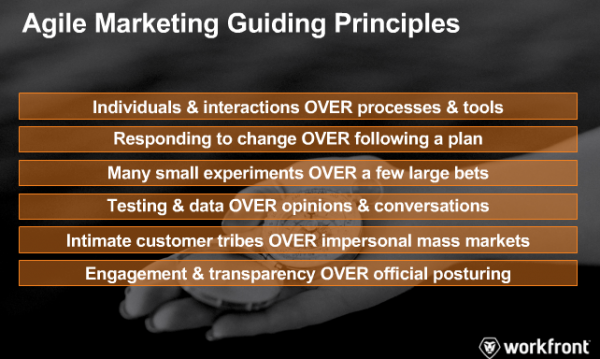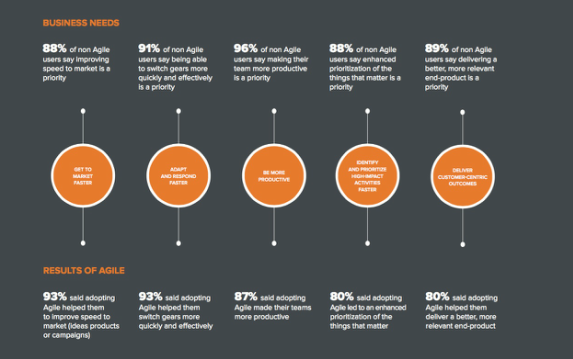
The agile methodology began in web development, but can be applied in other areas too — including marketing. Consider these tips for making marketing teams more agile.
Agile marketing is an adaptive methodology allowing marketers to respond to change, deal with small failures, and drive success quicker and with more certainty.
Being agile means to be self-organizing, light on procedure and policies, and focused on incremental accomplishments that move a project consistently forward. The agile methodology embraces flexibility, changing in response to customer need, and understanding what real-time data tells us.
Agile marketing is different from traditional marketing, which involves developing a product, service, or content initiative entirely and launching it at full-scale, alongside a large campaign effort. Agile marketing, instead, is smart, fast, and flexible. One way to look at it is that you’re making many small experiments, rather than a few large bets.

Related reading: What is agile marketing?
Becoming more agile doesn’t mean abandoning planning or changing direction all of the time. “It’s better to think of it as being responsive to incoming data,” Andrea Fryrear, Fox Content’s Chief Content Officer observed in a MarketingProfs agile marketing webinar this month.
Even embracing agile marketing methods on a partial basis can bring benefits to the team, Fryrear suggested, offering the following supporting statistics:

In the same webinar, Raechel Duplain, Scrum Master at Workfront, noted that marketing teams typically work in a top-down, very linear fashion. When step A is complete, B starts. When B is complete, step C commences. Yet this approach can take longer, doesn’t always leave room for change, and requires knowledge of the expected outcome during early planning.
Agile marketers, on the other hand, iterate. By moving to an agile working process, the team can more quickly develop a project. The end product may be “thinner” than the traditional project, but the idea is that it will be tested and revamped more quickly. This way, though, the team is developing a better overall product informed by data along the way.
To begin, know that agile teams are small teams. Small teams, given an opportunity to self-organize, can become very efficient and successful with only minimal oversight.
There are several approaches to the agile process. Those that specifically translate to marketing include scrum, kanban or a mixed methodology that incorporates data, iteration, and testing into the team’s efforts.
A first step, though, is to get a good overall picture of the marketing team’s efforts. In the scrum format, this would be determining “the backlog,” also known as the agile team’s To-Do list. Working together as a team, all stakeholders would gather all needs (external requests, internal plans) and prioritize them.
An agile team would then need to determine the duration of the first iteration (sprints are typically two to four weeks at most), what tasks need to be done in that sprint, estimate the time needed, and make assignments.
It’s critical to have accountability. Visually storyboarding progress with sticky notes on a cubicle wall or keeping track of workflow on a digital productivity tool can help assess team needs and progress. Continually measuring and evaluating progress is also important. A team might, for instance, have a daily, standing (yes, literally standing — to ensure expediency) meeting to check in, discuss and remove impediments.
At the end of a project, there should be a team meeting in which marketing can show off its deliverables and get initial feedback. At the same time, agile marketing also demands an ongoing review of the team performance with the continuous embrace of possible ways to improve the process.
Related reading: Agile sales tips for driving better ROI
Sources:
Fryrear, A. & Duplain, R. (2016, December 6). Agile Marketing 101 [webinar]. https://www.marketingprofs.com/marketing/online-seminars
Waters, K. (February 10, 2007). What is Agile? 10 Key Principles of Agile. https://www.allaboutagile.com/what-is-agile-10-key-principles/
by Jonathan Franchell, CEO of Ironpaper - For more tips and hacks: Need to remove a new line after h1 tags? Both web designers and SEO practitioners need to employ headline tags: H1, H2, H3 in several ways to improve web page structure and tag...

The Crowded Arena of the IT Marketplace Updated December 2024 The Information Technology (IT) landscape is experiencing rapid growth and intensifying competition. IT spending is projected to reach nearly 5.1 trillion U.S. dollars in 2024, a...

The marketing industry is transforming significantly due to generative AI and increasing market complexity. Gartner's prediction of a 25% decline in traditional search traffic suggests that the era of search engines is dying. AI tools, particularly...

Updated December, 2024 The field of digital marketing is evolving rapidly in response to new technology and changing buyer expectations. To help career-minded marketers, we’ve rounded up the top 10 skills needed to succeed in the field. These are...
